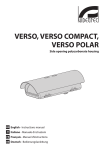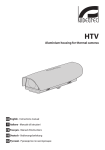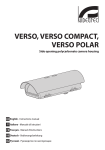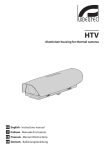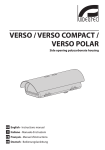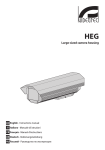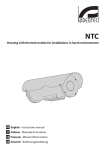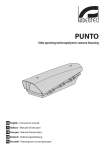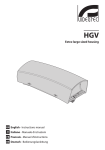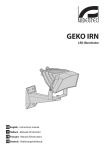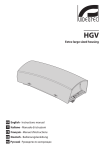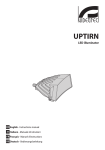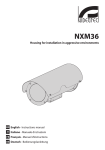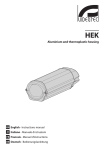Download Side opening aluminium housing
Transcript
HOV Side opening aluminium housing EN English - Instructions manual IT Italiano - Manuale di istruzioni FR Français - Manuel d’instructions DE Deutsch - Bedienungslanleitung HOV Side opening aluminium housing EN English - Instructions manual ENGLISH Contents 1 About this manual.......................................................................................................... 3 1.1 Typographical conventions................................................................................................................................... 3 2 Notes on copyright and information on trademarks................................................... 3 3 Safety rules..................................................................................................................... 3 4 Identification................................................................................................................... 4 4.1 Product description and type designation..................................................................................................... 4 4.2 Product markings..................................................................................................................................................... 4 5 Preparing the product for use....................................................................................... 5 5.1 Unpacking and contents........................................................................................................................................ 5 5.1.1 Unpacking................................................................................................................................................................................... 5 5.1.2 Contents....................................................................................................................................................................................... 5 5.2 Safely disposing of packaging material............................................................................................................ 5 5.3 Preparatory work before installation................................................................................................................. 5 5.3.1 Attaching the support............................................................................................................................................................ 5 6 Assembling and installing............................................................................................. 6 6.1 Installation................................................................................................................................................................... 6 6.1.1 How to open the housing...................................................................................................................................................... 6 6.1.2 How to install the camera...................................................................................................................................................... 6 6.1.3 Board description..................................................................................................................................................................... 7 6.1.4 Connection of the power supply line................................................................................................................................ 7 6.1.4.1 Type of cable.................................................................................................................................................................................................... 7 6.1.5 Installation of the version with double filter for air renewal..................................................................................... 8 6.1.6 Installation of the version with wiper............................................................................................................................... 8 6.1.7 Desiccant bag............................................................................................................................................................................ 8 7 Accessories...................................................................................................................... 9 7.1 Heater............................................................................................................................................................................ 9 7.1.1 Heater installation.................................................................................................................................................................... 9 7.2 Camera power supply............................................................................................................................................. 9 7.2.1 Camera power supply installation...................................................................................................................................... 9 7.3 Blower.........................................................................................................................................................................10 7.3.1 Blower installation..................................................................................................................................................................10 8 Instructions for normal operation............................................................................... 11 9 Maintaining and cleaning............................................................................................ 11 9.1 Window and plastic cover cleaning.................................................................................................................11 10 Disposal of waste materials....................................................................................... 11 11 Technical data............................................................................................................. 12 11.1 General.....................................................................................................................................................................12 11.2 Mechanical..............................................................................................................................................................12 11.3 Electrical..................................................................................................................................................................12 11.4 Environment..........................................................................................................................................................12 11.5 Certifications..........................................................................................................................................................12 12 Technical drawings..................................................................................................... 13 1 About this manual 1.1 Typographical conventions DANGER! High level hazard. Risk of electric shock. Disconnect the power supply before proceeding with any operation, unless indicated otherwise. WARNING! Medium level hazard. This operation is very important for the system to function properly. Please read the procedure described very carefully and carry it out as instructed. INFO Description of system specifications. We recommend reading this part carefully in order to understand the subsequent stages. 2 Notes on copyright and information on trademarks The quoted names of products or companies are trademarks or registered trademarks. The manufacturer declines all responsibility for any damage caused by an improper use of the appliances mentioned in this manual. Furthermore, the manufacturer reserves the right to modify its contents without any prior notice. The documentation contained in this manual has been collected with great care, the manufacturer, however, cannot take any liability for its use. The same thing can be said for any person or company involved in the creation and production of this manual. • The device must be installed only and exclusively by qualified technical personnel. • Before starting any operation, make sure the power supply is disconnected. • Do not use power supply cables that seem worn or old. • Never, under any circumstances, make any changes or connections that are not shown in this handbook. Improper use of the appliance can cause serious hazards, risking the safety of personnel and of the installation. • Use only original spare parts. Non-original spare parts could cause fire, electrical discharge or other hazards. • Before proceeding with installation check the supplied material to make sure it corresponds to the order specification by examining the identification labels (4.2 Product markings, page 4). • This device was designed to be permanently installed on a building or on a suitable structure. The device must be installed permanently before any operation. • When installing the device, comply with all the national standards. MNVCHOV32_1351_EN 3 Instructions manual - English - EN Before installing and using this unit, please read this manual carefully. Be sure to keep it handy for later reference. 3 Safety rules EN - English - Instructions manual • The electrical system to which the unit is connected must be equipped with a automatic bipolar circuit breaker. The circuit breaker for main supply voltage phase units must have a level of intervention of 20A max. The circuit breaker for low voltage units must have a level of intervention of 6A max. This circuit breaker must be of the Listed type. The minimum distance between the contacts must be 3mm (0.1in). The circuit breaker must be provided with protection against the fault current towards the ground (differential) and the overcurrent (magnetothermal). • For all connections, use cables that are able to withstand temperatures of at least 75°C (167°F). • Any device which could be installed inside the product must comply with the current safety standards. • Use Listed copper tube crimping lugs for the connection of the network conductors to the terminals. The copper tube crimping lugs must be suitable for the type of installation (from -20°C (-4°F) to +80°C (+176°F) min., V-0). Copper tube crimping lugs examples: RP, BP or YP (Cembre). • If the installation is NEMA TYPE 4X, the installer must replace the cable glands of the product with NEMA TYPE 4X cable glands. • Installation category (also called Overvoltage Category) specifies the level of mains voltage surges that the equipment will be subjected to. The category depends upon the location of the equipment, and on any external surge protection provided. Equipment in an industrial environment, directly connected to major feeders/short branch circuits, is subjected to Installation Category III. If this is the case, a reduction to Installation Category II is required. This can be achieved by use of an insulating transformer with an earthed screen between primary and secondary, or by fitting listed Surge Protective Devices (SPDs) from live to neutral and from neutral to earth. Listed SPDs shall be designed for repeated limiting of transient voltage surges, suitable rated for operating voltage and designated as follows: Type 2 (Permanently connected SPDs intended for installation on the load side of the service equipment overcurrent device); Nominal Discharge Current (In) 20kA min. For example: FERRAZ SHAWMUT, STT2240SPG-CN, STT2BL240SPG-CN rated 120/240Vac, (In=20kA). Maximum distance between installation and reduction is 5m. 4 • The product is designed to house only cameras that are properly certified (7W max). • A disconnecting device, readily and easily accessible, must be incorporated in the electrical system of the building for rapid intervention. • To connect the power supply line use the appropriate junction-box (UPTJBUL). For further information, refer to the product use and installation manual. 4 Identification 4.1 Product description and type designation Robust aluminium housing designed to simplify the installation and service and guarantee total protection against all environmental conditions. Its size makes it ideal for housing various combinations of standard cameras with fixed or compact zoom lenses. Very easy to install thanks to the side opening system that allows the full access to the camera, lenses and all internal connections. A wide range of accessories for mounting the equipment is available thereby satisfying all installation needs. 4.2 Product markings See the label attached to the product. MNVCHOV32_1351_EN Any change that is not expressly approved by the manufacturer will invalidate the guarantee. 5.1 Unpacking and contents 5.1.1 Unpacking 5.2 Safely disposing of packaging material The packaging material can all be recycled. The installer technician will be responsible for separating the material for disposal, and in any case for compliance with the legislation in force where the device is to be used. When returning a faulty product we recommend using the original packaging for shipping. When the product is delivered, make sure that the package is intact and that there are no signs that it has been dropped or scratched. 5.3 Preparatory work before installation If there are obvious signs of damage, contact the supplier immediately. 5.3.1 Attaching the support Keep the packaging in case you need to send the product for repairs. 5.1.2 Contents Check the contents to make sure they correspond with the list of materials as below: Instructions manual - English - EN 5 Preparing the product for use The product must be fastened with suitable equipment. The fastening means must guarantee the mechanical seal when a force equal to at least 4 times the weight of the device is applied. • Housing • Housing equipment: • Allen wrench • Spacers • Cable glands gaskets • Cable glands (x3) • Bolts and screws • Screws for camera • Instructions manual • Desiccant bag MNVCHOV32_1351_EN 5 EN - English - Instructions manual 6 Assembling and installing 6.1.2 How to install the camera Power supply can be provided by the board supplied with the product. Make sure the voltage values are appropriate. The assembly and installation must be performed only by skilled personnel. 6.1 Installation 6.1.1 How to open the housing Loosen the 2 screws on the side, turn the cover and the upper half of the body about the opening hinge axis. Open the housing as described previously (6.1.1 How to open the housing, page 6). Extract the internal support slide by partially loosening the fastening screws (01). Move the slide, by sliding it until the holes coincide with the slide locking screws (02). Fasten the camera with the 1/4" screw. If necessary, use the supplied spacers to correctly position the camera and optics (03). 01 03 02 Fig. 1 Fig. 2 Reposition the internal slide by tightening the previously loosened screws. Remove the conductors protective sheathing and connect them to terminal (J5, 6.1.3 Board description, page 7). The camera’s power supply cable conductors must be tied up with a cable tie next to the terminal. Keep the signalling and power supply cables separated from each other. 6 MNVCHOV32_1351_EN 6.1.3 Board description The board may appear different to that illustrated. Depending on the product version, the board may not be equipped with all functions. BOARD DESCRIPTION Connector Function J1 Board power supply (VIN)1 Remove the conductors protective sheathing and connect them to terminal (J1, 6.1.3 Board description, page 7). Make sure the earth conductor is at least 10mm longer than the others. J2 Auxiliary output (VOUT )2 J3 Heater power supply (VOUT ) J4 Tamper switch contacts3 J5 Camera power supply (VOUT )4 J7 Connector for power supply/jumper5 J8 Fan power supply (VOUT ) SW1 Insert the cables for the connection to the power supply line inside the housing through the cable glands. The cable glands are suitable for conductors with diameters of between 5mm and 10mm. The section of the cable inside the housing must be sufficiently long to allow connection. Suitably lock the cable glands. 6.1.4.1 Type of cable The cable used for the connection to the power supply line must be suitable for the intended use. Comply with the current national standards on electrical installations. Tamper switch3 Tab. 1 1 From 100Vac to 240Vac, 24Vac or12Vdc. 2 Same voltage applied to J1. 3 Optional. Different alternatives are available depending on the version. VOUT = 12Vdc or VOUT = 24Vac, in relation to the type of power supply installed (7.2.1 Camera power supply installation, page 9). VOUT = VIN, only for housings powered in 12Vdc or 24Vac, with jumper inserted in J7. 5 4 To install a power supply in 12Vdc or 24Vac refer to the relative chapter (7.2.1 Camera power supply installation, page 9). J8 SW1 J2 J7 J3 J1 J4 J5 Fig. 3 MNVCHOV32_1351_EN 7 Instructions manual - English - EN Connect the safety earth to the relative terminal of the J1 connector. 6.1.4 Connection of the power supply line 6.1.5 Installation of the version with double filter for air renewal EN - English - Instructions manual During installation pay attention to the orientation of the air inlet filter fins. 6.1.6 Installation of the version with wiper Open the housing as described previously (6.1.1 How to open the housing, page 6). Identify the terminal on the wiper board. CSP Fig. 6 Fig. 4 Depending on the angle of inclination of the housing, the orientation of the filter fins must prevent water penetrating in case of rain: Connect the wiper board to the power supply mains as shown in the figure. To guarantee the weatherproof, install the housing on the support following the inclination limits as shown in the picture. L ~ N P S C Fig. 7 Pressing the button activates the wiper. When the button is released the wiper blade will return to the rest position. 0˚ 45° If you have a receiver with the Wiper control function, connect the SW, PER and COM terminals respectively to terminals S, P and C of the board. 45° Close the housing. 6.1.7 Desiccant bag Take the dessicant salt bag out of its pack and insert it into the product. Fig. 5 8 Maximum tilt of the transversal axis: 0°. Maximum tilt of the longitudinal axis: ±45°. MNVCHOV32_1351_EN 7.2 Camera power supply 7 Accessories 7.1 Heater 7.1.1 Heater installation Open the housing as described previously (6.1.1 How to open the housing, page 6). Fix the heater kit to the prearranged points on the body of the housing. The pre-wired heating element (01) should be positioned between the 2 dissipators (02) before attachment to ensure contact and hence guarantee correct heat transmission. 7.2.1 Camera power supply installation Not usable in housings with wiper device installed. Pay attention to the voltage value used when the circuit is powered. Depending on requirements use the correct power supply kit. There are 2 types of camera power supply depending on requirements. Pass the heating wiring under the fixing slide of the camera. Fig. 9VIN from 100Vac to 240Vac, VOUT 12Vdc. 02 01 02 Fig. 10VIN 230Vac, VOUT 24Vac. Fig. 8 Plug the multipolar female connector into the corresponding male connector (J3, 6.1.3 Board description, page 7). Reposition the internal slide. Close the housing. MNVCHOV32_1351_EN 9 Instructions manual - English - EN For further details on configuration and use, refer to the relative manual. EN - English - Instructions manual Open the housing as described previously (6.1.1 How to open the housing, page 6). Fix the support bracket (02) using the screw (01). Place the power supply (03) on the support bracket. Secure it all with the screws (04) and the corner fixing bracket. 7.3 Blower 7.3.1 Blower installation Not usable in housings with cooling device and wiper installed. Pay attention to the voltage value used when the circuit is powered. Depending on requirements use the correct power supply kit. 04 05 01 03 The blower kit should be assembled according to the instructions to ensure a correct air circulation inside the housing. 02 Open the housing as described previously (6.1.1 How to open the housing, page 6). Fix the blower using the corner bracket and screws. Fig. 11 Plug the multipolar female connector into the corresponding male connector (J7, 6.1.3 Board description, page 7). Fig. 13 Plug the multipolar female connector into the corresponding male connector (J8, 6.1.3 Board description, page 7). Close the housing. Fig. 12 Close the housing. 10 MNVCHOV32_1351_EN Do not use the wiper when the outside temperature is below 0°C or in case of ice. 9 Maintaining and cleaning Before doing any technical work on the device, disconnect the power supply. 9.1 Window and plastic cover cleaning Avoid ethyl alcohol, solvents, hydrogenated hydrocarbide, strong acid and alkali. Such products may irreparably damage the surface. 10 Disposal of waste materials This symbol mark and recycle system are applied only to EU countries and not applied to the countries in the other area of the world. Your product is designed and manufactured with high quality materials and components which can be recycled and reused. This symbol means that electrical and electronic equipment, at their end-of-life, should be disposed of separately from your household waste. Please dispose of this equipment at your local Community waste collection or Recycling centre. In the European Union there are separate collection systems for used electrical and electronic products. Surface dirt should be rinsed away with water and then the window cleaned with a neutral soap diluted with water, or specific products for spectacle lens cleaning. These should be applied with a soft cloth. MNVCHOV32_1351_EN 11 Instructions manual - English - EN 8 Instructions for normal operation 11 Technical data EN - English - Instructions manual 11.1 General Constructed from aluminium Sunshield in ABS Epoxypolyester powder painting, RAL9002 colour Stainless steel external screws 11.2 Mechanical Cable glands: 3xM16 Glass window (WxH): 118x75mm (4.6x2.7in) Internal usable area (WxH): 100x70mm (3.9x2.7in) Internal usable length (with or without accessories): 250mm (9.8in) Unit weight: 3kg (6.6lb) 11.3 Electrical Power supply/Current consumption (empty version): • From 12Vdc to 24Vdc, 1A max • From 12Vac to 24Vac, 1A max, 50/60Hz • From 120Vac to 230Vac, 400mA max, 50/60Hz Power supply/Current consumption (Version with heater, Ton 15°C±3°C (59°F ±5°F), Toff 22°C±3°C (77°F±5°F)): Power supply/Current consumption (version with heater fan assistant, continuous duty): • 12Vdc, 400mA max • 24Vac, 200mA max, 50/60Hz • From 100Vac to 240Vac, 40mA max, 50/60Hz (with wide range power supply) Power supply/Current consumption (version with blower and thermostat for models with double filter for air renewal, Ton 35°C±3°C (95°F±5°F), Toff 20°C±3°C (71°F±5°F)): • 12Vdc, 400mA max • 24Vac, 200mA max, 50/60Hz Power supply/Current consumption (version with integrated wiper): • 24Vac, 1.85A max, 50/60Hz • 230Vac, 40mA max, 50/60Hz Camera power supply: • VIN from 100Vac to 240Vac, 50/60Hz VOUT 12Vdc, 1A • VIN 230Vac, 50/60Hz VOUT 24Vac, 400mA, 50/60Hz 11.4 Environment Indoor/Outdoor • From 12Vdc to 24Vdc, 3A max Operating temperature (with heater): From -20°C (-4°F) to +60°C (140°F) • From 12Vac to 24Vac, 3A max, 50/60Hz Resistant to salty fog, to 1000 hours (ISO9227) • From 120Vac to 230Vac, 400mA max, 50/60Hz 11.5 Certifications Power supply/Current consumption (version with double heater, Ton 15°C±3°C (59°F ±5°F), Toff 22°C±3°C (77°F±5°F)): • From 12Vdc to 24Vdc, 6A max • From 12Vac to 24Vac, 6A max, 50/60Hz CE: EN61000-6-3, EN50130-4, EN60950-1, EN60950-22 EN60529 IP66/IP67 (with cable glands) EN60529 IP66/IP67 (with special gaskets and bracket with internal cable channel) EN60529 IP55 (with bracket with internal cable channel) EN60529 IP44 (with double filter for air renewal) 12 MNVCHOV32_1351_EN 12 Technical drawings 514 Instructions manual - English - EN The dimensions of the drawings are in millimetres. 176 B 27 98 131 160 A B A 76 100 250 70 A-A B-B 188 70 40 113 60 = 13 = 53 225 400 39 62 39 140 213 88 70 AREA UTILE AREA UTILE 88 430 412 ˚ 90 400 R100 Fig. 14HOV. MNVCHOV32_1351_EN 13 Headquarters Italy Videotec S.p.A. France Videotec France S.à.r.l. Asia Pacific Videotec (HK) Ltd Americas Videotec Security, Inc. Via Friuli, 6 - I-36015 - Schio (VI) Italy Tel. +39 0445 697411 - Fax +39 0445 697414 Email: [email protected] Unit C 24 Floor - Gold King Industrial Building 35-41, Tai Lin Pai Road - Kwai Chung, NT, Hong Kong Tel. +852 2333 0601 - Fax +852 2311 0026 Email: [email protected] Voie du Futur, Zac des Portes - 27100 - Val-de-Reuil, France Tel. +33 2 32094900 - Fax +33 2 32094901 Email: [email protected] 35 Gateway Drive, Suite 100 - Plattsburgh, NY 12901 - U.S.A. Tel. +1 518 825 0020 - Fax +1 518 825 0022 Email: [email protected] - www.videotec.us www.videotec.com MNVCHOV32_1351_EN HOV Custodia in alluminio ad apertura laterale IT Italiano - Manuale di istruzioni ITALIANO Sommario 1 Informazioni sul presente manuale.............................................................................. 3 1.1 Convenzioni tipografiche...................................................................................................................................... 3 2 Note sul copyright e informazioni sui marchi commerciali......................................... 3 3 Norme di sicurezza......................................................................................................... 3 4 Identificazione................................................................................................................ 4 4.1 Descrizione e designazione del prodotto........................................................................................................ 4 4.2 Marcatura del prodotto.......................................................................................................................................... 4 5 Preparazione del prodotto per l'utilizzo....................................................................... 5 5.1 Disimballaggio e contenuto................................................................................................................................. 5 5.1.1 Disimballaggio........................................................................................................................................................................... 5 5.1.2 Contenuto................................................................................................................................................................................... 5 5.2 Smaltimento in sicurezza dei materiali di imballaggio............................................................................... 5 5.3 Lavoro preparatorio prima dell’installazione.................................................................................................. 5 5.3.1 Fissaggio del supporto........................................................................................................................................................... 5 6 Assemblaggio e installazione........................................................................................ 6 6.1 Installazione................................................................................................................................................................ 6 6.1.1 Apertura della custodia.......................................................................................................................................................... 6 6.1.2 Installazione della telecamera............................................................................................................................................. 6 6.1.3 Descrizione della scheda....................................................................................................................................................... 7 6.1.4 Collegamento della linea di alimentazione.................................................................................................................... 7 6.1.4.1 Tipo di cavo...................................................................................................................................................................................................... 7 6.1.5 Installazione della versione con doppio filtro per ricambio dell'aria..................................................................... 8 6.1.6 Installazione della versione con tergicristallo................................................................................................................ 8 6.1.7 Sacchetto disidratante............................................................................................................................................................ 8 7 Accessori.......................................................................................................................... 9 7.1 Riscaldamento........................................................................................................................................................... 9 7.1.1 Installazione del riscaldamento.......................................................................................................................................... 9 7.2 Alimentatore per telecamera............................................................................................................................... 9 7.2.1 Installazione dell’alimentatore per telecamera............................................................................................................. 9 7.3 Ventilatore.................................................................................................................................................................10 7.3.1 Installazione del ventilatore...............................................................................................................................................10 8 Istruzioni di funzionamento ordinario....................................................................... 11 9 Manutenzione e pulizia................................................................................................ 11 9.1 Pulizia del vetro e delle parti in plastica.........................................................................................................11 10 Smaltimento dei rifiuti............................................................................................... 11 11 Dati tecnici.................................................................................................................. 12 11.1 Generale..................................................................................................................................................................12 11.2 Meccanica...............................................................................................................................................................12 11.3 Elettrico....................................................................................................................................................................12 11.4 Ambiente.................................................................................................................................................................12 11.5 Certificazioni..........................................................................................................................................................12 12 Disegni tecnici............................................................................................................ 13 1 Informazioni sul presente manuale 1.1 Convenzioni tipografiche PERICOLO! Pericolosità elevata. Rischio di scosse elettriche. Prima di eseguire qualsiasi operazione assicurarsi di togliere tensione al prodotto, salvo diversa indicazione. ATTENZIONE! Pericolosità media. L'operazione è molto importante per il corretto funzionamento del sistema. Si prega di leggere attentamente la procedura indicata e di eseguirla secondo le modalità previste. INFO Descrizione delle caratteristiche del sistema. Si consiglia di leggere attentamente per comprendere le fasi successive. 2 Note sul copyright e informazioni sui marchi commerciali I nomi di prodotto o di aziende citati sono marchi commerciali o marchi commerciali registrati appartenenti alle rispettive società. Il produttore declina ogni responsabilità per eventuali danni derivanti da un uso improprio delle apparecchiature menzionate in questo manuale. Si riserva inoltre il diritto di modificarne il contenuto senza preavviso. Ogni cura è stata posta nella raccolta e nella verifica della documentazione contenuta in questo manuale, tuttavia il produttore non può assumersi alcuna responsabilità derivante dall'utilizzo della stessa. Lo stesso dicasi per ogni persona o società coinvolta nella creazione e nella produzione di questo manuale. • L'installazione e la manutenzione del dispositivo deve essere eseguita solo da personale tecnico qualificato. • Prima di eseguire qualsiasi operazione assicurarsi di togliere tensione al prodotto. • Non utilizzare cavi di alimentazione con segni di usura o invecchiamento. • Non effettuare per nessun motivo alterazioni o collegamenti non previsti in questo manuale. L'uso di apparecchi non idonei può portare a gravi pericoli per la sicurezza del personale e dell'impianto. • Utilizzare solo parti di ricambio originali. Pezzi di ricambio non originali potrebbero causare incendi, scariche elettriche o altri pericoli. • Prima di procedere con l'installazione controllare che il materiale fornito corrisponda alle specifiche richieste esaminando le etichette di marcatura (4.2 Marcatura del prodotto, pagina 4). • Questo dispositivo è stato progettato per essere installato in maniera permanente su un edificio o su una struttura adeguata. Il dispositivo deve essere installato in maniera permanente prima di effettuare qualsiasi operazione. • Si devono rispettare le normative nazionali per l'installazione del dispositivo. MNVCHOV32_1351_IT 3 Manuale di istruzioni - Italiano - IT Prima di installare e utilizzare questa unità, leggere attentamente questo manuale. Conservare questo manuale a portata di mano come riferimento futuro. 3 Norme di sicurezza IT - Italiano - Manuale di istruzioni • L’impianto elettrico al quale è collegata l’unità deve essere dotato di un interruttore di protezione bipolare automatico. L'interruttore per le unità a tensione di rete deve avere un livello di intervento di 20A max. L'interruttore per le unità a bassa tensione deve avere un livello di intervento di 6A max. Tale interruttore deve essere di tipo Listed. La distanza minima tra i contatti deve essere di 3mm. L’interruttore deve essere provvisto di protezione contro la corrente di guasto verso terra (differenziale) e la sovracorrente (magnetotermico). • Ogni dispositivo che può essere installato all’interno del prodotto deve essere conforme alle norme di sicurezza attuali. • Se l'installazione deve essere di tipo NEMA TYPE 4X, l'installatore deve sostituire i pressacavi del prodotto con dei pressacavi di tipo NEMA TYPE 4X. • La categoria di installazione (detta anche categoria di sovratensione) specifica i livelli della tensione transitoria di rete alla quale l’apparato è soggetto. La categoria dipende dal luogo di installazione e dalla presenza di dispositivi di protezione contro le sovratensioni. Un dispositivo per ambienti industriali, connesso ai rami principali dell’impianto di alimentazione è soggetto alla categoria di installazione III. Se questo è il caso, è richiesta una riduzione alla categoria II. Ciò può essere ottenuto utilizzando un trasformatore di isolamento con schermatura connessa a terra tra il primario ed il secondario, o tramite l’impiego di dispositivi di protezione contro le sovratensioni (SPD), UL listed, connessi tra la fase ed il neutro a tra il neutro e terra. I dispositivi SPD UL listed, dovranno essere predisposti per limitare sovratensioni transitorie in modo ripetitivo e per la seguenti condizioni nominali di funzionamento: Tipo 2 (Dispositivi SPD connessi permanentemente alla rete di alimentazione, per istallazioni dal lato del carico del dispositivo di servizio); Corrente nominale di scarica (In) 20kA minimi. Si possono utilizzare ad esempio: FERRAZ SHAWMUT, ST23401PG-CN, ST240SPG-CN specificati per 120/240Vac, (In=20kA). La distanza massima tra l'installazione e la riduzione è di 5m. 4 • Per tutte le connessioni, utilizzare cavi idonei a sopportare temperature di almeno 75°C. • Il prodotto è progettato per alloggiare solo telecamere opportunamente certificate (7W max). • Un dispositivo di scollegamento, prontamente e facilmente accessibile, deve essere incorporato nell'impianto elettrico dell'edificio per un intervento rapido. • Per la connessione della linea di alimentazione utilizzare l’apposita scatola di connessione (UPTJBUL). Fare riferimento al manuale d’uso ed installazione del prodotto per ulteriori informazioni. • Utilizzare dei capicorda Listed per la connessione dei conduttori di rete ai morsetti. I capicorda devo essere adeguati al tipo di installazione (da -20°C a +80°C min., V-0). Esempi di capicorda: RP, BP o YP (Cembre). 4 Identificazione 4.1 Descrizione e designazione del prodotto Robusta custodia in alluminio progettata per semplificare l’installazione ed il servizio e garantire una protezione totale a tutte le condizioni ambientali. Le sue dimensioni la rendono adatta ad alloggiare svariate combinazioni di telecamere standard con ottiche fisse o zoom compatti. Estremamente semplice da installare, l’apertura laterale facilita ampiamente l’accesso alla telecamera, alle ottiche e a tutte le connessioni interne. É disponibile un’ampia gamma di accessori di montaggio che permette di soddisfare qualsiasi esigenza di installazione. 4.2 Marcatura del prodotto Vedere l’etichetta posta sul prodotto. MNVCHOV32_1351_IT 5 Preparazione del prodotto per l'utilizzo 5.1 Disimballaggio e contenuto 5.1.1 Disimballaggio Alla consegna del prodotto verificare che l'imballo sia integro e non abbia segni evidenti di cadute o abrasioni. In caso di evidenti segni di danno all'imballo contattare immediatamente il fornitore. Conservare l'imballo nel caso sia necessario inviare il prodotto in riparazione. 5.1.2 Contenuto Controllare che il contenuto sia corrispondente alla lista del materiale sotto elencata: I materiali d'imballo sono costituiti interamente da materiale riciclabile. Sarà cura del tecnico installatore smaltirli secondo le modalità di raccolta differenziata o comunque secondo le norme vigenti nel Paese di utilizzo. In caso di restituzione del prodotto malfunzionante è consigliato l'utilizzo dell'imballaggio originale per il trasporto. 5.3 Lavoro preparatorio prima dell’installazione 5.3.1 Fissaggio del supporto Il prodotto deve essere fissato con mezzi adeguati. I mezzi di fissaggio devono garantire la tenuta meccanica applicando una forza pari almeno a 4 volte il peso complessivo dell’apparecchiatura. • Custodia • Dotazione per custodia: • Chiave a brugola • Distanziali • Guarnizioni per pressacavi • Pressacavi (x3) • Viteria • Viti per telecamera • Manuale di istruzioni • Sacchetto disidratante MNVCHOV32_1351_IT 5 Manuale di istruzioni - Italiano - IT Qualsiasi cambiamento non espressamente approvato dal costruttore fa decadere la garanzia. 5.2 Smaltimento in sicurezza dei materiali di imballaggio 6 Assemblaggio e installazione IT - Italiano - Manuale di istruzioni L'assemblaggio e l'installazione vanno eseguiti solo da personale qualificato. 6.1 Installazione 6.1.1 Apertura della custodia Svitare le 2 viti poste sul fianco, far ruotare tettuccio e corpo superiore attorno all’asse delle cerniere di apertura. 6.1.2 Installazione della telecamera L'alimentazione può essere fornita dalla scheda in dotazione al prodotto. Accertarsi che i valori di tensione siano adeguati. Aprire la custodia come descritto precedentemente ( 6.1.1 Apertura della custodia, pagina 6). Estrarre la slitta interna di appoggio svitando parzialmente le viti di fissaggio (01). Fare scorrere la slitta fino a fare coincidere i fori con le viti di bloccaggio (02). Fissare la telecamera con la vite da 1/4". Se necessario utilizzare i distanziali in dotazione per collocare nel modo corretto la telecamera e l'ottica (03). 01 03 02 Fig. 1 Fig. 2 Riposizionare la slitta interna fissando le viti precedentemente allentate. Togliere la guaina di protezione dei conduttori e collegarli al morsetto (J5, 6.1.3 Descrizione della scheda, pagina 7). I conduttori del cavo di alimentazione della telecamera devono essere fissati tra loro con una fascetta in prossimità del morsetto. Tenere separati i cavi di alimentazione da quelli di segnale. 6 MNVCHOV32_1351_IT 6.1.3 Descrizione della scheda Collegare la terra di sicurezza al relativo morsetto del connettore J1. La scheda, a seconda della versione del prodotto, potrebbe non essere dotata di tutte le funzionalità. DESCRIZIONE DELLA SCHEDA Connettore Funzione J1 Alimentazione della scheda (VIN)1 Togliere la guaina di protezione dei conduttori e collegarli al morsetto (J1, 6.1.3 Descrizione della scheda, pagina 7). Avere cura di lasciare il conduttore di terra più lungo degli altri di almeno 10mm. J2 Uscita ausiliaria (VOUT )2 J3 Alimentazione del riscaldamento (VOUT ) J4 Contatti dello switch antiapertura3 J5 Alimentazione della telecamera (VOUT )4 J7 Connettore per alimentatore/ponticello5 J8 Alimentazione del ventilatore (VOUT ) SW1 Introdurre i cavi di collegamento alla linea di alimentazione all'interno della custodia attraverso i pressacavi. I pressacavi sono adatti per conduttori con diametro compreso tra 5mm e 10mm. Il tratto di cavo all'interno della custodia deve essere sufficientemente lungo da permettere il collegamento. Serrare opportunamente i pressacavi. Manuale di istruzioni - Italiano - IT L'aspetto della scheda potrebbe differire da quello illlustrato. 6.1.4 Collegamento della linea di alimentazione 6.1.4.1 Tipo di cavo Il tipo cavo da utilizzare per il collegamento alla linea di alimentazione deve essere compatibile con l'impiego previsto. Attenersi alle regole nazionali in vigore riguardo le installazioni elettriche. Switch antiapertura3 Tab. 1 1 Da 100Vac a 240Vac, 24Vac o12Vdc. 2 Stessa tensione applicata a J1. 3 Opzionale. Sono possibili diverse alternative a seconda della versione. VOUT = 12Vdc o VOUT = 24Vac, in relazione al tipo di alimentatore installato (7.2.1 Installazione dell’alimentatore per telecamera, pagina 9). VOUT = VIN, solo per custodie alimentate in 12Vdc o 24Vac, con ponticello inserito in J7. 5 4 Per installare un alimentatore in 12Vdc o 24Vac fare riferimento al relativo capitolo (7.2.1 Installazione dell’alimentatore per telecamera, pagina 9). J8 SW1 J2 J7 J3 J1 J4 J5 Fig. 3 MNVCHOV32_1351_IT 7 6.1.5 Installazione della versione con doppio filtro per ricambio dell'aria Aprire la custodia come descritto precedentemente ( 6.1.1 Apertura della custodia, pagina 6). Individuare il morsetto della scheda tergicristallo. IT - Italiano - Manuale di istruzioni Durante l'installazione prestare attenzione all'orientamento delle alette del filtro di ingresso dell'aria. 6.1.6 Installazione della versione con tergicristallo CSP Fig. 6 Fig. 4 A seconda dell'angolo di inclinazione della custodia, l'orientamento delle alette del filtro deve prevenire la penetrazione di acqua in caso di pioggia. Collegare la scheda del tergicristallo alla rete di alimentazione come illustrato in figura. Al fine di garantire il grado di protezione, installare la custodia al supporto rispettando i limiti di inclinazione riportati in figura. L ~ N P S C Fig. 7 Premendo il pulsante si attiva il tergicristallo. Rilasciando il pulsante la spazzola del tergicristallo si porta in posizione di riposo. 0˚ 45° Chiudere la custodia. 45° Fig. 5 8 Nel caso si disponga di un ricevitore con funzione di comando Wiper, collegare i morsetti SW, PER e COM rispettivamente ai terminali S, P e C della scheda. 6.1.7 Sacchetto disidratante Estrarre il sacchetto disidratante dalla confezione e inserirlo nel prodotto. Massima inclinazione dell'asse trasversale: 0°. Massima inclinazione dell'asse longitudinale: ±45°. MNVCHOV32_1351_IT 7.2 Alimentatore per telecamera 7 Accessori Per ulteriori dettagli sulla configurazione e l’utilizzo fare riferimento al manuale del relativo accessorio. 7.1.1 Installazione del riscaldamento Aprire la custodia come descritto precedentemente ( 6.1.1 Apertura della custodia, pagina 6). Fissare il kit di riscaldamento nei punti predisposti sul corpo custodia. La resistenza precablata (01) deve essere interposta fra i 2 dissipatori (02) prima del fissaggio per garantirne il contatto e assicurare in questo modo una corretta trasmissione del calore. Non utilizzabile nelle custodie munite di sistema tergicristallo. Manuale di istruzioni - Italiano - IT 7.1 Riscaldamento 7.2.1 Installazione dell’alimentatore per telecamera Prestare attenzione al valore di tensione utilizzata quando si alimenta il circuito. A seconda delle esigenze utilizzare il kit di alimentazione corretto. Gli alimentatori che possono essere installati sono di 2 categorie a seconda delle esigenze. Passare il cablaggio del riscaldamento sotto alla slitta per il fissaggio della telecamera. Fig. 9VIN da 100Vac a 240Vac, VOUT 12Vdc. 02 01 02 Fig. 10VIN 230Vac, VOUT 24Vac. Fig. 8 Inserire il connettore femmina multipolare nel corrispondente connettore maschio (J3, 6.1.3 Descrizione della scheda, pagina 7). Riposizionare la slitta interna. Chiudere la custodia. MNVCHOV32_1351_IT 9 Aprire la custodia come descritto precedentemente ( 6.1.1 Apertura della custodia, pagina 6). IT - Italiano - Manuale di istruzioni Utilizzando la vite (01) fissare la staffa di appoggio (02). Posizionare l'alimentatore (03) sulla staffa di appoggio. Fissare il tutto con le viti (04) e la staffa di fissaggio ad angolo (05). 7.3 Ventilatore 7.3.1 Installazione del ventilatore Non utilizzabile nelle custodie munite di sistema per il raffreddamento e tergicristallo installato. 04 05 Prestare attenzione al valore di tensione utilizzata quando si alimenta il circuito. A seconda delle esigenze utilizzare il kit di alimentazione corretto. 01 03 02 Il ventilatore deve essere montato come da istruzioni per garantire una corretta circolazione dell’aria all’interno della custodia. Aprire la custodia come descritto precedentemente ( 6.1.1 Apertura della custodia, pagina 6). Fissare il ventilatore tramite la staffetta angolare in dotazione utilizzando le viti. Fig. 11 Inserire il connettore femmina multipolare nel corrispondente connettore maschio (J7, 6.1.3 Descrizione della scheda, pagina 7). Fig. 13 Fig. 12 Inserire il connettore femmina multipolare nel corrispondente connettore maschio (J8, 6.1.3 Descrizione della scheda, pagina 7). Chiudere la custodia. Chiudere la custodia. 10 MNVCHOV32_1351_IT 8 Istruzioni di funzionamento ordinario 9 Manutenzione e pulizia Prima di effettuare interventi tecnici sull’apparecchio togliere l’alimentazione elettrica. 9.1 Pulizia del vetro e delle parti in plastica Questo simbolo e il sistema di riciclaggio sono validi solo nei paesi dell'EU e non trovano applicazione in altri paesi del mondo. Manuale di istruzioni - Italiano - IT Non utilizzare il tergicristallo quando la temperatura esterna è inferiore a 0°C o in presenza di ghiaccio. 10 Smaltimento dei rifiuti Il vostro prodotto è costruito con materiali e componenti di alta qualità, che sono riutilizzabili o riciclabili. Prodotti elettrici ed elettronici che portano questo simbolo alla fine dell'uso devono essere smaltiti separatamente dai rifiuti casalinghi. Vi preghiamo di smaltire questo apparecchio in un Centro di raccolta o in un'Ecostazione. Nell'Unione Europea esistono sistemi di raccolta differenziata per prodotti elettrici ed elettronici. Evitare alcool etilico, solventi, idrocarburi idrogenati, acidi forti e alcali. L’utilizzo di detti prodotti danneggia in modo irreparabile la superficie trattata. Si consigliano saponi neutri diluiti con acqua o prodotti specifici per la pulizia delle lenti degli occhiali con l’utilizzo di un panno morbido. MNVCHOV32_1351_IT 11 11 Dati tecnici 11.1 Generale Costruzione in alluminio IT - Italiano - Manuale di istruzioni Tettuccio in ABS Verniciatura a polveri di epossipoliestere, colore RAL9002 Viteria esterna in acciaio inox 11.2 Meccanica Pressacavi: 3xM16 Finestra in vetro (WxH): 118x75mm Dimensioni utili interne (WxH): 100x70mm Lunghezza utile interna (con o senza accessori): 250mm Peso unitario: 3kg 11.3 Elettrico Tensione di alimentazione/Corrente assorbita (versione vuota): • Da 12Vdc a 24Vdc, 1A max • Da 12Vac a 24Vac, 1A max, 50/60Hz • Da 120Vac a 230Vac, 400mA max, 50/60Hz Tensione di alimentazione/Corrente assorbita (versione con riscaldamento, Ton 15°C±3°C, Toff 22°C±3°C): • Da 12Vdc a 24Vdc, 3A max Tensione di alimentazione/Corrente assorbita (versione con ventilatore a ciclo continuo per assistenza riscaldamento): • 12Vdc, 400mA max • 24Vac, 200mA max, 50/60Hz • Da 100Vac a 240Vac, 40mA max, 50/60Hz (completo di alimentatore wide-range) Tensione di alimentazione/Corrente assorbita (versione con ventilatore e termostato per modelli con doppio filtro per ricambio dell'aria, Ton 35°C±3°C, Toff 20°C±3°C): • 12Vdc, 400mA max • 24Vac, 200mA max, 50/60Hz Tensione di alimentazione/Corrente assorbita (versione con tergicristallo integrato): • 24Vac, 1.85A max, 50/60Hz • 230Vac, 40mA max, 50/60Hz Alimentatore per telecamera: • VIN da 100Vac a 240Vac, 50/60Hz VOUT 12Vdc, 1A • VIN 230Vac, 50/60Hz VOUT 24Vac, 400mA, 50/60Hz 11.4 Ambiente Interno/Esterno Temperatura di esercizio (con riscaldamento): Da -20°C a +60°C • Da 12Vac a 24Vac, 3A max, 50/60Hz Resistente alle nebbie saline, fino a 1000 ore (ISO9227) • Da 120Vac a 230Vac, 400mA max, 50/60Hz 11.5 Certificazioni Tensione di alimentazione/Corrente assorbita (versione con doppio riscaldamento, Ton 15°C±3°C, Toff 22°C±3°C): • Da 12Vdc a 24Vdc, 6A max • Da 12Vac a 24Vac, 6A max, 50/60Hz CE: EN61000-6-3, EN50130-4, EN60950-1, EN60950-22 EN60529 IP66/IP67 (con pressacavi) EN60529 IP66/IP67 (con anelli di tenuta e supporto per passaggio interno cavi) EN60529 IP55 (con supporto per passaggio interno cavi) EN60529 IP44 (con doppio filtro per ricambio d’aria) 12 MNVCHOV32_1351_IT 12 Disegni tecnici Le dimensioni dei disegni sono espresse in millimetri. 514 B Manuale di istruzioni - Italiano - IT 176 27 98 131 160 A B A 76 100 250 70 A-A B-B 188 70 40 113 60 = 13 = 53 225 400 39 62 39 140 213 88 70 AREA UTILE AREA UTILE 88 430 412 ˚ 90 400 R100 Fig. 14HOV. MNVCHOV32_1351_IT 13 Headquarters Italy Videotec S.p.A. France Videotec France S.à.r.l. Asia Pacific Videotec (HK) Ltd Americas Videotec Security, Inc. Via Friuli, 6 - I-36015 - Schio (VI) Italy Tel. +39 0445 697411 - Fax +39 0445 697414 Email: [email protected] Unit C 24 Floor - Gold King Industrial Building 35-41, Tai Lin Pai Road - Kwai Chung, NT, Hong Kong Tel. +852 2333 0601 - Fax +852 2311 0026 Email: [email protected] Voie du Futur, Zac des Portes - 27100 - Val-de-Reuil, France Tel. +33 2 32094900 - Fax +33 2 32094901 Email: [email protected] 35 Gateway Drive, Suite 100 - Plattsburgh, NY 12901 - U.S.A. Tel. +1 518 825 0020 - Fax +1 518 825 0022 Email: [email protected] - www.videotec.us www.videotec.com MNVCHOV32_1351_IT HOV Caisson en aluminium à ouverture latérale FR Français - Manuel d’instructions FRANÇAIS Sommaire 1 À propos de ce mode d’emploi...................................................................................... 3 1.1 Conventions typographiques.............................................................................................................................. 3 2 Notes sur le copyright et informations sur les marques de commerce...................... 3 3 Normes de securité......................................................................................................... 3 4 Identification................................................................................................................... 4 4.1 Description et désignation du produit............................................................................................................. 4 4.2 Marquage du produit.............................................................................................................................................. 4 5 Préparation du produit en vue de l’utilisation............................................................. 5 5.1 Déballage et contenu.............................................................................................................................................. 5 5.1.1 Déballage.................................................................................................................................................................................... 5 5.1.2 Contenu....................................................................................................................................................................................... 5 5.2 Élimination sans danger des matériaux d’emballage.................................................................................. 5 5.3 Opérations à effectuer avant l’installation....................................................................................................... 5 5.3.1 Fixation du support................................................................................................................................................................. 5 6 Assemblage et installation............................................................................................ 6 6.1 Installation................................................................................................................................................................... 6 6.1.1 Ouverture du caisson.............................................................................................................................................................. 6 6.1.2 Installation de la caméra........................................................................................................................................................ 6 6.1.3 Description de la carte............................................................................................................................................................ 7 6.1.4 Connexion de la ligne d'alimentation............................................................................................................................... 7 6.1.4.1 Type de câble................................................................................................................................................................................................... 7 6.1.5 Installation de la version avec double filtre pour le changement d'air................................................................. 8 6.1.6 Installation de la version avec essuie-glace.................................................................................................................... 8 6.1.7 Sachet déshydratant............................................................................................................................................................... 8 7 Accessoires...................................................................................................................... 9 7.1 Chauffage.................................................................................................................................................................... 9 7.1.1 Installation du chauffage....................................................................................................................................................... 9 7.2 Alimentation pour caméra.................................................................................................................................... 9 7.2.1 Installation de l’alimentateur pour caméra..................................................................................................................... 9 7.3 Ventilateur.................................................................................................................................................................10 7.3.1 Installation du ventilateur...................................................................................................................................................10 8 Instructions de fonctionnement courant................................................................... 11 9 Entretien et nettoyage................................................................................................. 11 9.1 Entretiens de la vitre et des parties en plastique........................................................................................11 10 Élimination des déchets............................................................................................. 11 11 Données techniques................................................................................................... 12 11.1 Généralités..............................................................................................................................................................12 11.2 Mécanique..............................................................................................................................................................12 11.3 Électrique................................................................................................................................................................12 11.4 Environnement.....................................................................................................................................................12 11.5 Certifications..........................................................................................................................................................12 12 Dessins techniques..................................................................................................... 13 1 À propos de ce mode d’emploi Avant d’installer et d’utiliser cet appareil, veuillez lire attentivement ce mode d’emploi. Conservez-le à portée de main pour pouvoir vous y reporter en cas de besoin. DANGER! Risque élevé. Risque de choc électrique. Sauf indication contraire, sectionner l'alimentation avant de procéder à toute opération. ATTENTION! Risque moyen. Opération extrêmement importante en vue d’un fonctionnement correct du système; lire avec attention les opérations indiquées et s’y conformer rigoureusement. REMARQUE Description des caractéristiques du système. Il est conseillé de procéder à une lecture attentive pour une meilleure compréhension des phases suivantes. 2 Notes sur le copyright et informations sur les marques de commerce Les noms de produit ou de sociétés cités sont des marques de commerce ou des marques de commerce enregistrées. Le producteur décline toute responsabilité pour les dommages éventuels dus à une utilisation non appropriée des appareils mentionnés dans ce manuel. On réserve en outre le droit d’en modifier le contenu sans préavis. La documentation contenue dans ce manuel a été rassemblée et vérifiée avec le plus grand soin, cependant, le producteur ne peut pas s’assumer aucune responsabilité dérivante de l’emploi de celle là. La même chose vaut pour chaque personne ou société impliquées dans la création et la production de ce manuel. • L’installation et l’entretien du dispositif doivent être exclusivement être effectués par un personnel technique qualifié. • Sectionner l'alimentation avant de procéder à toute opération. • Ne pas utiliser de câbles d’alimentation usés ou endommagés. • Ne procéder sous aucun prétexte à des modifications ou des connexions non prévues dans ce manuel. L'utilisation d’appareils non adéquats peut comporter des dangers graves pour la sécurité du personnel et de l’installation. • Utiliser uniquement des pièces de rechange d’origine. Les pièces non d’origine peuvent être source d’incendies, de choc électrique ou autres. • Avant de procéder à l’installation, contrôler que le matériel fourni correspond à la commande et examiner les étiquettes de marquage (4.2 Marquage du produit, page 4). • Cette appareil est conçu pour une installation permanente sur un bâtiment ou une structure adéquate. L'appareil doit être installé d'une façon permanente avant d'effectuer toute opération. • Il faut respecter les législations nationales pour l'installation du dispositif. MNVCHOV32_1351_FR 3 Manuel d'instructions - Français - FR 1.1 Conventions typographiques 3 Normes de securité FR - Français - Manuel d'instructions • L'installation électrique à laquelle l'unité est branchée doit être équipée d'un interrupteur de protection bipolaire automatique. L'interrupteur pour les unités a tensione di rete doit avoir un niveau d'intervention de 20A max. L'interrupteur pour les unités à basse tension doit avoir un niveau d'intervention de 6A max. Cet interrupteur doit être de type Listed. La distance minimale entre les contacts doit être de 3mm. L'interrupteur doit être équipé de protection contre le courant de défaut vers la terre (différentiel) et le surintensité (magnétothermique). • Chaque appareils pouvant être installés à l'intérieur du produit doivent être conformes aux normes de sécurité en vigueur. • Si l'installation doit être de type NEMA TYPE 4X, l'installateur devra remplacer les presse-étoupes du produit avec des presse-étoupes de type NEMA TYPE 4X. • La catégorie d’installation (ou catégorie de surtension) spécifie les niveaux de la tension de secteur correspondant à l’appareil. La catégorie dépend du lieu d’installation et du dispositif de protection contre les surtensions installé. En cas d’environnement industriel directement connecté aux circuits de dérivation du système d’alimentation, l’équipement est classé dans la catégorie d’installation III. Dans ce cas, un déclassement à la catégorie II est nécessaire et peut être obtenu au moyen d’un transformateur d’isolement avec blindage électrostatique entre le primaire et le secondaire ou en utilisant des dispositifs de protection contre les surtensions (SPD) entre la phase et le neutre et entre le neutre et la terre. Les dispositifs SPD UL cités doivent être prévus pour limiter les surtensions transitoires en mode répétitif et pour les conditions nominales de fonctionnement suivantes : Type 2 (dispositifs SPD reliés en permanence au côté charge du côté du dispositif de protection contre les surintensités) ; courant nominal de décharge (In) 20kA min. Exemples d’utilisation possible : FERRAZ SHAWMUT, ST23401PG-CN, ST240SPG-CN spécifiés pour 120/240Vca, (In=20kA). La distance maximale entre installation et réduction est de 5m. 4 • Pour tous les branchements, utiliser les câbles spécifiques pouvant résister à des températures d'au moins 75°C. • Le projet a été conçu pour ne loger que des caméras dûment certifiées (7W max). • Un dispositif de déconnexion, rapide et facile d'accès, doit être incorporé dans le circuit électrique du bâtiment pour une intervention rapide. • Pour raccorder la ligne d'alimentation utiliser le boîtier de connexion spécifique (UPTJBUL). Pour plus d'informations, se référer au manuel d'utilisation et d'installation du produit. • Utiliser des cosses Listed pour relier les conducteurs de réseau aux bornes. Les cosses doit être appropriés au type d'installation (de -20°C à +80°C min., V-0). Exemples de cosses: RP, BP ou YP (Cembre). 4 Identification 4.1 Description et désignation du produit Robuste caisson en aluminium conçu pour simplifier l’installation et le service et garantir une protection totale dans toutes les conditions environnementales. Ses dimensions le rendent adapté pour loger différentes combinaisons de caméras standards avec optiques fixes ou zooms compacts. Très simple à installer, l'ouverture latérale facilite largement l'accès à la caméra, aux optiques et à toutes les connexions internes. Une vaste gamme d’accessoires de montage est disponible, permettant de solutionner tout problème d’installation. 4.2 Marquage du produit Voir l'étiquette positionné sur le produit. MNVCHOV32_1351_FR 5 Préparation du produit en vue de l’utilisation Toute modification non approuvée expressément par le fabricant entraînera l’annulation de la garantie. 5.1.1 Déballage Lors de la livraison du produit, vérifier que l’emballage est en bon état et l’absence de tout signe évident de chute ou d’abrasion. En cas de dommages évidents, contacter immédiatement le fournisseur. Conserver l’emballage en cas de nécessité d’expédition du produit pour réparation. 5.1.2 Contenu Contrôler que le contenu correspond à la liste matériel indiquée ci-dessous: Le matériel d’emballage est entièrement composé de matériaux recyclables. Le technicien chargé de l’installation est tenu de l’éliminer conformément aux dispositions en matière de collecte sélective et selon les normes en vigueur dans le pays d’utilisation. En cas de retour du produit défectueux, il est conseillé d'utiliser l'emballage original pour le transport. 5.3 Opérations à effectuer avant l’installation 5.3.1 Fixation du support Le produit doit être fixé à l'aide des moyens appropriés. Les moyens de fixation doivent garantir l'étanchéité mécanique et appliquer une force égale au moins à 4 fois le poids total de l’appareil. • Caisson • Dotation pour caisson: • Clé Allen • Entretoises • Joints pour presse-étoupes • Presse-étoupes (x3) • Vis • Vis pour caméra • Manuel d'instructions • Sachet déshydratant MNVCHOV32_1351_FR 5 Manuel d'instructions - Français - FR 5.1 Déballage et contenu 5.2 Élimination sans danger des matériaux d’emballage 6 Assemblage et installation 6.1.2 Installation de la caméra L'alimentation peut être dotée de la carte fournie avec le produit fournie. S'assurer que les valeurs de tension soient appropriées. FR - Français - Manuel d'instructions L’assemblage et l’installation doivent être effectués par un personnel qualifié. 6.1 Installation Ouvrir le caisson comme décrit précédemment (6.1.1 Ouverture du caisson, page 6). 6.1.1 Ouverture du caisson Extraire la glissière interne d’appui en dévissant partiellement les vis de fixation (01). Dévisser les 2 vis placées sur le côté, faire tourner le toit pare-soleil et le corps supérieur autour de l’axe des charnières d’ouverture. Déplacer la glissière jusqu’à ce que les trous coïncident avec les vis de blocage (02). Fixer la caméra avec la vis de 1/4". Si nécessaire, utiliser les entretoises fournies pour placer de façon correcte la caméra et l’optique (03). 01 03 02 Fig. 1 Fig. 2 Replacer la glissière interne en fixant les vis précédemment desserrées. Enlever la gaine de protection des conducteurs et les brancher à la borne (J5, 6.1.3 Description de la carte, page 7). Les conducteurs du câble d'alimentation de la caméra doivent être fixés entre eux avec une collier en proximité de la borne. Garder les câbles d'alimentation séparés de ceux de signal. 6 MNVCHOV32_1351_FR 6.1.3 Description de la carte Faire le branchement de sécurité à la terre de la borne correspondante du connecteur J1. L'aspect de la carte pourrait être différer de celui qui est illustré. DESCRIPTION DE LA CARTE Connecteur Fonction J1 Alimentation de la carte (VIN)1 Introduire les câbles de branchement à la ligne d'alimentation à l'intérieur du caisson à l'aide des presse-étoupes. Les presse-câbles sont prévus pour des conducteurs avec un diamètre compris entre 5mm et 10mm. La partie de câble à l'intérieur de la gaine doit être suffisamment long pour permettre le branchement. Serrer opportunément les presseétoupes. Enlever la gaine de protection des conducteurs et les brancher à la borne (J1, 6.1.3 Description de la carte, page 7). Prendre soin de laisser le conducteur de terre plus long que les autres d'au moins 10mm. J2 Sortie auxiliaire (VOUT )2 J3 Alimentation du chauffage (VOUT ) J4 Contact du switch antiapertura?3 6.1.4.1 Type de câble J5 Alimentation de la camera (VOUT )4 J7 Connecteur pour alimentateur/barrette5 J8 Alimentation du ventilateur (VOUT ) SW1 Switch anti-ouverture3 Tab. 1 1 De 100Vac à 240Vac, 24Vac ou12Vdc. 2 Meme tension appliquée à J1. 3 En option. Il existe différentes alternatives selon la version. VOUT = 12Vdc ou VOUT = 24Vac, en relation au type d'alimentateur installé (7.2.1 Installation de l’alimentateur pour caméra, page 9). VOUT = VIN, uniquement pour les gaines alimentées en 12Vdc ou 24Vac, avec le shunt inséré dans J7. 5 Le type de câble à utiliser pour le branchement à la ligne d'alimentation doit être compatible avec l'emploi prévu. S'en tenir aux règles nationales en vigueur concernant les installations électriques. 4 Pour installer un alimentateur en 12Vdc ou 24Vac faire référence au chapitre correspondant (7.2.1 Installation de l’alimentateur pour caméra, page 9). J8 SW1 J2 J7 J3 J1 J4 J5 Fig. 3 MNVCHOV32_1351_FR 7 Manuel d'instructions - Français - FR La carte, selon la version du produit, pourrait ne pas être munie de toutes les fonctions. 6.1.4 Connexion de la ligne d'alimentation 6.1.5 Installation de la version avec double filtre pour le changement d'air Durant l'installation prêter l'installation à l'orientation des ailettes du filtre d'entrée de l'air. 6.1.6 Installation de la version avec essuie-glace Ouvrir le caisson comme décrit précédemment (6.1.1 Ouverture du caisson, page 6). Identifier la borne de la carte de l'essui-glace. Fig. 6 Fig. 4 Selon l'angle d'inclinaison de la gaine, l'orientation des ailettes du filtre doit empêcher à l'eau de pénétrer en cas de pluie. Brancher la carte de l'essuie-glace au réseau d'alimentation selon la figure. Pour garantir un degré de protection, installer le caisson au support en respectant les limites d'inclinaison selon la figure. L ~ N P S C Fig. 7 En pressant le bouton on active l'essuie-glace. En relâchant le bouton-poussoir, la brosse de l’essuieglace se mettra en position de repos. 45° 0˚ Si l’on dispose d’un récepteur ayant la fonction de commande Wiper, brancher les bornes SW, PER et COM respectivement aux terminaux S, P et C de la carte. Fermer le caisson. 45° FR - Français - Manuel d'instructions CSP 6.1.7 Sachet déshydratant Prenez le sachet de sel desséchant de son emballage et le placer dans le produit. Fig. 5 8 Inclination maximal de l’axe transversal: 0°. Inclination maximal de l’axe longitudinal: ±45°. MNVCHOV32_1351_FR 7.2 Alimentation pour caméra 7 Accessoires Pour de plus amples informations sur la configuration et l'utilisation, consulter le manuel de l'accessoire correspondant. 7.1 Chauffage Ouvrir le caisson comme décrit précédemment (6.1.1 Ouverture du caisson, page 6). Fixer le kit de chauffage aux points prédisposées sur le corps du caisson. La résistance précâblée (01) doit être placée entre les 2 dissipateurs (02) avant la fixation pour en garantir le contact et assurer de cette façon une bonne transmission de la chaleur. Pas utilisable pour les caissons équipés de système essuie-glace installé. Il faut faire attention au valeur de tension utilisée en alimentant le circuit. Selon les exigences utiliser le kit d’alimentation appropriè. Les alimentateurs qui peuvent être installés sont de 2 catégories selon les exigences. Passer le câblage du chauffage sous la glissière pour la fixation de la caméra. Fig. 9VIN de 100Vac à 240Vac, VOUT 12Vdc. 02 01 02 Fig. 10VIN 230Vac, VOUT 24Vac. Fig. 8 Insérer le connecteur femelle multipolaire dans connecteur mâle correspondant (J3, 6.1.3 Description de la carte, page 7). Replacer la glissière interne. Fermer le caisson. MNVCHOV32_1351_FR 9 Manuel d'instructions - Français - FR 7.1.1 Installation du chauffage 7.2.1 Installation de l’alimentateur pour caméra Ouvrir le caisson comme décrit précédemment (6.1.1 Ouverture du caisson, page 6). En utilisant la vis (01) fixer la bride de soutien (02). Positionner l'alimentateur (03) sur la bride de soutien. Fixer le tout avec les vis (04) et la bride de fixation d'angle (05). 7.3 Ventilateur 7.3.1 Installation du ventilateur Pas utilisable pour les caissons équipés de système pour le refroidissement installé. Il faut faire attention au valeur de tension utilisée en alimentant le circuit. Selon les exigences utiliser le kit d’alimentation appropriè. 04 FR - Français - Manuel d'instructions 05 01 03 Le ventilateur doit être monté d’après les instructions pour garantir une bonne circulation de l’air à l’intérieur du caisson. 02 Ouvrir le caisson comme décrit précédemment (6.1.1 Ouverture du caisson, page 6). Fixer le ventilateur à l’aide du petit étrier de support en angle fournie en utilisant les vis. Fig. 11 Insérer le connecteur femelle multipolaire dans connecteur mâle correspondant (J7, 6.1.3 Description de la carte, page 7). Fig. 13 Insérer le connecteur femelle multipolaire dans connecteur mâle correspondant (J8, 6.1.3 Description de la carte, page 7). Fig. 12 Fermer le caisson. Fermer le caisson. 10 MNVCHOV32_1351_FR 8 Instructions de fonctionnement courant Ne pas utiliser l’essuie-glace lorsque la température extérieure est inférieure à 0°C ou en cas de givre. Sectionner l’alimentation électrique avant toute intervention technique sur l’appareil. 9.1 Entretiens de la vitre et des parties en plastique On doit éviter alcool éthylique, solvants, hydrocarbures hydro-génés, acides forts et alcali. L’emploi de ce type de produits abîme d’une façon irréparable la surface traitée. Ce symbole et le système de recyclage ne sont appliqués que dans les pays UE et non dans les autres pays du monde. Votre produit est conçu et fabriqué avec des matèriels et des composants de qualité supérieure qui peuvent être recyclés et réutilisés. Ce symbole signifie que les équipements électriques et électroniques en fin de vie doivent être éliminés séparément des ordures ménagères. Nous vous prions donc de confier cet équipement à votre Centre local de collecte ou Recyclage. Dans l’Union Européenne, il existe des systèmes sélectifs de collecte pour les produits électriques et électroniques usagés. Nous conseillons l’emploi, avec un chiffon souple, de savons neutres dilués avec de l’eau ou bien de produits spécifiques pour le nettoyage des vitres de lunettes. MNVCHOV32_1351_FR 11 Manuel d'instructions - Français - FR 9 Entretien et nettoyage 10 Élimination des déchets 11 Données techniques 11.1 Généralités Construction en aluminium Double toit en ABS FR - Français - Manuel d'instructions Vernissage avec poudres époxypolyester, couleur RAL9002 Visserie extérieure en acier inox 11.2 Mécanique Presse-étoupes: 3xM16 Fenêtre en verre (WxH): 118x75mm Surface intérieure utile (WxH): 100x70mm Longueur intérieure utile (avec ou sans accessoires): 250mm Poids net: 3kg 11.3 Électrique Tension d’alimentation/Courant absorbé (Version vide): • De 12Vdc à 24Vdc, 1A max • De 12Vac à 24Vac, 1A max, 50/60Hz • De 120Vac à 230Vac, 400mA max, 50/60Hz Tension d’alimentation/Courant absorbé (version avec chauffage, Ton 15°C±3°C, Toff 22°C±3°C): • De 12Vdc à 24Vdc, 3A max • De 12Vac à 24Vac, 3A max, 50/60Hz • De 120Vac à 230Vac, 400mA max, 50/60Hz Tension d’alimentation/Courant absorbé (version avec double chauffage, Ton 15°C±3°C, Toff 22°C±3°C): • De 12Vdc à 24Vdc, 6A max • De 12Vac à 24Vac, 6A max, 50/60Hz Tension d’alimentation/Courant absorbé (version avec ventilateur à cycle continu pour assistance chauffage): • 12Vdc, 400mA max • 24Vac, 200mA max, 50/60Hz • De 100Vac à 240Vac, 40mA max, 50/60Hz (avec alimentation wide range) Tension d’alimentation/Courant absorbé (version avec ventilateur et thermostat avec double filtre pour le renouvellement de l’air, Ton 35°C±3°C, Toff 20°C±3°C): • 12Vdc, 400mA max • 24Vac, 200mA max, 50/60Hz Tension d’alimentation/Courant absorbé (version avec essuie-glace intégré): • 24Vac, 1.85A max, 50/60Hz • 230Vac, 40mA max, 50/60Hz Alimentation pour caméra: • VIN de 100Vac à 240Vac, 50/60Hz VOUT 12Vdc, 1A • VIN 230Vac, 50/60Hz VOUT 24Vac, 400mA, 50/60Hz 11.4 Environnement Intérieur/Extérieur Température de fonctionnement (avec chauffage): De -20°C à +60°C Résistant aux brumes salines, jusqu’à 1000 heures (ISO9227) 11.5 Certifications CE: EN61000-6-3, EN50130-4, EN60950-1, EN60950-22 EN60529 IP66/IP67 (avec presse-étoupes) EN60529 IP66/IP67 (avec bagues d’étanchéité et support pour passage interne des câbles) EN60529 IP55 (avec support pour passage interne des câbles) EN60529 IP44 (avec double filtre pour le renouvellement de l’air) 12 MNVCHOV32_1351_FR 12 Dessins techniques Les dimensions des dessins sont exprimées en millimètres. 514 176 B A 27 98 131 160 Manuel d'instructions - Français - FR B A 76 100 250 70 A-A B-B 188 70 40 113 60 = 13 = 53 225 400 39 62 39 140 213 88 70 AREA UTILE AREA UTILE 88 430 412 ˚ 90 400 R100 Fig. 14HOV. MNVCHOV32_1351_FR 13 Headquarters Italy Videotec S.p.A. France Videotec France S.à.r.l. Asia Pacific Videotec (HK) Ltd Americas Videotec Security, Inc. Via Friuli, 6 - I-36015 - Schio (VI) Italy Tel. +39 0445 697411 - Fax +39 0445 697414 Email: [email protected] Unit C 24 Floor - Gold King Industrial Building 35-41, Tai Lin Pai Road - Kwai Chung, NT, Hong Kong Tel. +852 2333 0601 - Fax +852 2311 0026 Email: [email protected] Voie du Futur, Zac des Portes - 27100 - Val-de-Reuil, France Tel. +33 2 32094900 - Fax +33 2 32094901 Email: [email protected] 35 Gateway Drive, Suite 100 - Plattsburgh, NY 12901 - U.S.A. Tel. +1 518 825 0020 - Fax +1 518 825 0022 Email: [email protected] - www.videotec.us www.videotec.com MNVCHOV32_1351_FR HOV Aluminiumgehäuse mit Seitenöffnung DE Deutsch - Bedienungslanleitung DEUTSCH Inhaltsverzeichnis 1 Allgemeines.................................................................................................................... 3 1.1 Schreibweisen............................................................................................................................................................ 3 2 Anmerkungen zum Copyright und Informationen zu den Handelsmarken.............. 3 3 Sicherheitsnormen......................................................................................................... 3 4 Identifizierung................................................................................................................ 4 4.1 Beschreibung und Bezeichnung des Produktes............................................................................................ 4 4.2 Kennzeichnung des Produkts.............................................................................................................................. 4 5 Vorbereitung des Produktes auf den Gebrauch.......................................................... 5 5.1 Entfernen der Verpackung und Inhalt............................................................................................................... 5 5.1.1 Entfernen der Verpackung.................................................................................................................................................... 5 5.1.2 Inhalt............................................................................................................................................................................................. 5 5.2 Sichere Entsorgung der Verpackungsmaterialien........................................................................................ 5 5.3 Auf die Installation vorbereitende Tätigkeiten............................................................................................... 5 5.3.1 Befestigung der Halterung.................................................................................................................................................... 5 6 Zusammenbau und Installation.................................................................................... 6 6.1 Installation................................................................................................................................................................... 6 6.1.1 Öffnung des Schutzgehause................................................................................................................................................ 6 6.1.2 Installation der Kamera.......................................................................................................................................................... 6 6.1.3 Beschreibung der Karte.......................................................................................................................................................... 7 6.1.4 Anschluss der Stromversorgung......................................................................................................................................... 7 6.1.4.1 Kabelart............................................................................................................................................................................................................. 7 6.1.5 Installation der Version mit Doppelfilter für den Luftaustausch............................................................................. 8 6.1.6 Installation der Ausführung mit Scheibenwischer....................................................................................................... 8 6.1.7 Beutelchen.................................................................................................................................................................................. 8 7 Zubehör........................................................................................................................... 9 7.1 Heizung........................................................................................................................................................................ 9 7.1.1 Installation der Heizung......................................................................................................................................................... 9 7.2 Kameranetzteil........................................................................................................................................................... 9 7.2.1 Installation des Netzteil für Kamera................................................................................................................................... 9 7.3 Lüfter...........................................................................................................................................................................10 7.3.1 Installation des Lüfters.........................................................................................................................................................10 8 Anleitung für den normalen Betrieb........................................................................... 11 9 Wartung und Reinigung............................................................................................... 11 9.1 Reinigung des Glases und der Kunststoffteile.............................................................................................11 10 Müllentsorgungsstellen............................................................................................. 11 11 Technische Daten........................................................................................................ 12 11.1 Allgemeines............................................................................................................................................................12 11.2 Mechanik.................................................................................................................................................................12 11.3 Elektrik......................................................................................................................................................................12 11.4 Umgebung.............................................................................................................................................................12 11.5 Zertifizierungen....................................................................................................................................................12 12 Technische Zeichnungen........................................................................................... 13 1 Allgemeines Lesen Sie bitte vor dem Installieren und dem Verwenden dieses Gerätes die Bedienungsanleitung sorgfältig durch. Bewahren Sie sie zum späteren Nachschlagen auf. 1.1 Schreibweisen ACHTUNG! Mittlere Gefährdung. Der genannte Vorgang hat große Bedeutung für den einwandfreien Betrieb des Systems: es wird gebeten, sich die Verfahrensweise anzulesen und zu befolgen. ANMERKUNG Beschreibung der Systemmerkmale. Eine sorgfältige Lektüre wird empfohlen, um das Verständnis der folgenden Phasen zu gewährleisten. 2 Anmerkungen zum Copyright und Informationen zu den Handelsmarken Die angeführten Produkt- oder Firmennamen sind Handelsmarken oder eingetragene Handelsmarken. Der Hersteller lehnt jede Haftung für eventuelle Schäden ab, die aufgrund unsachgemäßer Anwendung der in diesem Handbuch erwähnten Geräte entstanden ist. Ferner behält er sich das Recht vor, den Inhalt ohne Vorkündigung abzuändern. Die Dokumentation in diesem Handbuch wurde sorgfältig ausgeführt und überprüft, dennoch kann der Hersteller keine Haftung für die Verwendung übernehmen. Dasselbe gilt für jede Person oder Gesellschaft, die bei der Schaffung oder Produktion von diesem Handbuch miteinbezogen ist. • Die Installation und Wartung der Vorrichtung ist technischen Fachleuten vorbehalten. • Unterbrechen Sie die Stromversorgung, bevor die beschriebenen Arbeiten durchgeführt werden. • Es dürfen keine Versorgungskabel mit Verschleißoder Alterungsspuren verwendet werden. • Unter keinen Umständen dürfen Veränderungen oder Anschlüsse vorgenommen werden, die in diesem Handbuch nicht genannt sind. Der Gebrauch ungeeigneten Geräts kann die Sicherheit des Personals und der Anlage schwer gefährden. • Es dürfen nur Original-Ersatzteile verwendet werden. Nicht originale Ersatzteile können zu Bränden, elektrischen Entladungen oder anderen Gefahren führen. • Vor der Installation ist anhand des Kennzeichnungsschildes nachzuprüfen, ob das gelieferte Material die gewünschten Eigenschaften (4.2 Kennzeichnung des Produkts, Seite 4). • Die Einrichtung ist für den dauerhaften Einbau in ein Gebäude oder eine andere geeignete Struktur konzipiert. Vor jeder Operation muss die Einrichtung dauerhaft eingebaut werden. • Die nationalen Vorschriften für die Installation der Einrichtung sind einzuhalten. MNVCHOV32_1351_DE 3 Bedienungslanleitung - Deutsch - DE GEFAHR! Erhöhte Gefährdung. Stromschlaggefahr. Falls nichts anderes angegeben, unterbrechen Sie die Stromversorgung, bevor die beschriebenen Arbeiten durchgeführt werden. 3 Sicherheitsnormen DE - Deutsch - Bedienungslanleitung • Die elektrische Anlage, an der die Einheit angeschlossen ist, muss mit einem automatischen zweipoligen Schutzschalter versehen werden. Der Schalter für die mit Netzspannung betriebenen Einheiten muss eine Auslöseschwelle von max. 20A haben. Der Schalter für die mit Niederspannung betriebenen Einheiten muss eine Auslöseschwelle von max. 6A haben. Dieser Schalter muss vom Typ Listed sein. Zwischen den Kontakten muss mindestens ein Abstand von 3mm vorhanden sein. Der Schalter muss eine Schutzeinrichtung gegen Erde Fehlerstrom (Differenzial) und gegen Überstrom haben (magnetothermisch). • Jede Art in das Produkt installierbares Gerät muss den geltenden Sichereitsnormen genügen. • Bei einer Installation vom Typ NEMA TYPE 4X müssen die Kabelschellen des Produkts durch Kabelschellen vom Typ NEMA TYPE 4X ersetzt werden. • Die Installationskategorie (auch als Überspannungskategorie bezeichnet) gibt den Pegel der Netzspannungsstöße an, denen die Ausrüstung ausgesetzt ist. Die Kategorie hängt vom Installationsort der Ausrüstung und von den externen Schutzeinrichtungen gegen Spannungsstöße ab. Ausrüstungen in einer gewerblichen Umgebung, die direkt mit den Hauptzweigen der Versorgungsanlage verbunden sind, gehören zur Installationskategorie III. In diesem Fall ist eine Abstufung auf Installationskategorie II erforderlich. Dies kann durch den Einsatz eines Isoliertransformators mit einem geerdeten Schirm zwischen Primär- und Sekundärwicklung erreicht werden. Alternativ können UL-gelistete Überspannungsschutzvorrichtungen (SPD) von Fase zu Nullleiter und von Nullleiter zur Erde geführt werden. UL-gelistete Überspannungsschutzvorrichtungen sind für die wiederholte Begrenzung kurzzeitig auftretender Spannungsspitzen und für die folgenden nominellen Betriebsbedingungen auszulegen: Typ 2 (Dauerhaft angeschlossene Überspannungsschutzvorrichtungen für die Installation auf der Ladungsseite der Hilfseinrichtung); Nennentladestrom (In) 20kA min. Benutzt werden können beispielsweise: FERRAZ SHAWMUT, STT2240SPG-CN, STT2BL240SPGCN, spezifiziert für 120/240Vac, (In=20kA). Der maximale Abstand zwischen dem Einbau und der Abkürzung ist 5m. 4 • Benutzen Sie für alle Verbindungen Kabel, die bis mindestens 75°C hitzebeständig sind. • Das Produkt kann nur für entsprechend zertifizierte Kameras benutzt werden (7W max). • Eine sofort und problemlos zugängliche Abtrennvorrichtung muss in die Elektroanlage des Gebäudes eingebaut werden, um einen schnellen Eingriff zu garantieren. • Für den Anschluss der Versorgungsleitung den entsprechenden Anschlusskasten verwenden (UPTJBUL). Für weitere Informationen siehe Bedienungs- und Installationshandbuch des Produktes. • Für den Anschluss der Netzleiter an die Klemmen Listed-Kabelschuhe verwenden. Die Kabelschuhe müssen für die Art der Installation geeignet sein. (von -20°C bis +80°C min., V-0). Beispiele für Kabelschuhe: RP, BP oder YP (Cembre). 4 Identifizierung 4.1 Beschreibung und Bezeichnung des Produktes Robustes Aluminiumgehäuse, das zur Vereinfachung von Installation und Wartung konstruiert ist und vollständigen Schutz gegen alle Umgebungsbedingungen bietet. Aufgrund seiner Abmessungen eignet es sich für die Aufnahme diverser Kombinationen aus Standardkameras und festen Optiken oder kompakten Zoomoptiken. Äußerst einfache Installation, durch die seitliche Öffnung wird der Zugang zur Videokamera, den Optiken und allen innenliegenden Anschlüssen erleichtert. Eine große Auswahl an Montagezubehör ist lieferbar, um allen Installationanforderungen zu entsprechen. 4.2 Kennzeichnung des Produkts Siehe die Etikett auf dem Produkt. MNVCHOV32_1351_DE 5 Vorbereitung des Produktes auf den Gebrauch Jede vom Hersteller nicht ausdrücklich genehmigte Veränderung führt zum Verfall der Gewährleistungsrechte. 5.1.1 Entfernen der Verpackung Bei der Lieferung des Produktes ist zu prüfen, ob die Verpackung intakt ist oder offensichtliche Anzeichen von Stürzen oder Abrieb aufweist. Bei offensichtlichen Schadensspuren an der Verpackung muss umgehend der Lieferant verständigt werden. Bewahren Sie die Verpackung auf für den Fall, dass das Produkt zur Reparatur eingesendet werden muss. Die Verpackungsmaterialien sind vollständig wiederverwertbar. Es ist Sache des Installationstechnikers, sie getrennt, auf jeden Fall aber nach den geltenden Vorschriften des Anwendungslandes zu entsorgen. Im Falle der Rückgabe des nicht korrekt funktionierenden Produktes empfiehlt sich die Verwendung der Originalverpackung für den Transport. Bedienungslanleitung - Deutsch - DE 5.1 Entfernen der Verpackung und Inhalt 5.2 Sichere Entsorgung der Verpackungsmaterialien 5.3 Auf die Installation vorbereitende Tätigkeiten 5.3.1 Befestigung der Halterung Das Produkt muss mit geeigneten Mitteln befestigt werden. Die Befestigungsmittel müssen die mechanische Festigkeit beim Anlegen von mindestens dem 4-fachen Gesamtgewicht des Gerätes garantieren. 5.1.2 Inhalt Prüfen Sie, ob der Inhalt mit der nachstehenden Materialliste übereinstimmt: • Gehäuse • Innensechskantschlüssel: • Innensechskantschlüssel • Abstandsstücke • Dichtungen für Kabelschelle • Kabelschellen (x3) • Schrauben • Schrauben für Kamera • Bedienungslanleitung • Beutelchen MNVCHOV32_1351_DE 5 6 Zusammenbau und Installation 6.1.2 Installation der Kamera Die Stromversorgung muss über die Karte erfolgen, die im Lieferumfang des Geräts enthalten ist. Prüfen, dass die Spannungswerte angemessen sind. DE - Deutsch - Bedienungslanleitung Zusammenbau und Installation sind qualifizierten Fachleuten vorbehalten. 6.1 Installation Das Gehäuse öffnen, wie vorstehend beschrieben ( 6.1.1 Öffnung des Schutzgehause, Seite 6). 6.1.1 Öffnung des Schutzgehause Den internen Auflageschlitten herausziehen, indem man die Befestigungsschrauben teilweise löst (01). Die beiden an der Flanke befindlichen Schrauben abdrehen, nun die Haube und den oberen Korpus um die Achse der Öffnungsscharniere drehen. Nun den Schlitten soweit gleiten lassen, bis seine Bohrungen mit den Befestigungsschrauben übereinstimmen (02). Befestigen Sie die Kamera mit der 1/4"-Schraube. Falls erforderlich, kann die Kamera samt Optik mit Hilfe der bei liegenden Paßstücke ausgerichtet werden (03). Abb. 1 01 03 02 Abb. 2 Bringen Sie nun den internen Schlitten wieder an seine Position und fixieren ihn mit den vorher gelockerten Schrauben. Die Schutzummantelung der Leiter entfernen und die Leiter an die Klemme anschließen (J5, 6.1.3 Beschreibung der Karte, Seite 7). Die Leiter des Kabels für die Versorgung der Kamera müssen in Klemmennähe fest miteinander mit einem Kabelbinder verbunden werden. Die Versorgungskabel von den Signalkabeln getrennt halten. 6 MNVCHOV32_1351_DE 6.1.3 Beschreibung der Karte 6.1.4 Anschluss der Stromversorgung Die Schutzerde an Verbinder J1 mit der zugehörigen Klemme anschließen. Die Abbildung kann von der tatsächlichen Karte abweichen. Je nach Geräteausführung verfügt die Karte möglicherweise nicht über alle Funktionen. BESCHREIBUNG DER KARTE Die Kabel für den Anschluss an die Versorgungsleitung durch die Kabelschellen ins Gehäuseinnere führen. Die Kabelshellen eignen sich für Leiter mit Durchmesser zwischen 5mm und 10mm. Der Kabelabschnitt im Gehäuse muss ausreichend lang sein, damit der Anschluss möglich ist. Ziehen Sie die Kabelschellen in geeigneter Weisefest. Verbinder Funktion J1 Platinenversorgung (VIN)1 J2 Hilfsausgang (VOUT )2 Achten Sie darauf, dass der Erdleiter mindestens 10mm länger gelassen wird als die anderen Kabel. J3 Heizungsversorgung (VOUT ) 6.1.4.1 Kabelart J4 Kontakte des Öffnungsschutzschalters3 J5 Kameraversorgung (VOUT )4 J7 Verbinder für Netzteil/Überbrückung5 Die für den Anschluss an die Versorgungsleitung benutzte Kabelart muss für den vorgesehenen Gebrauch geeignet sein. Beachten Sie die geltenden nationalen Vorschriften bezüglich Elektroinstallationen. J8 Stromversorgung des Lüfters (VOUT ) SW1 Öffnungssicherer Switch3 Tab. 1 1 2 Die gleiche Spannung liegt an J1 an. 3 Wahlfrei. Je nach Ausführung sind mehrere Alternativen möglich. VOUT = 12Vdc oder VOUT = 24Vac, je nach Art des installierten Netzteils (7.2.1 Installation des Netzteil für Kamera, Seite 9). VOUT = VIN, nur für mit 12V-Gleichstrom oder 24V-Wechselstrom versorgte Gehäuse, mit an J7 angeschlossener Brücke 5 Bedienungslanleitung - Deutsch - DE Die Schutzummantelung der Leiter entfernen und die Leiter an die Klemme anschließen (J1, 6.1.3 Beschreibung der Karte, Seite 7). Von 100Vac bis 240Vac, 24Vac oder12Vdc. 4 Um ein 12V-Gleichstrom- oder 24V-WechselstromNetzteil zu installieren, bitte das entsprechende Kapitel beachten. (7.2.1 Installation des Netzteil für Kamera, Seite 9). J8 SW1 J2 J7 J3 J1 J4 J5 Abb. 3 MNVCHOV32_1351_DE 7 6.1.5 Installation der Version mit Doppelfilter für den Luftaustausch 6.1.6 Installation der Ausführung mit Scheibenwischer Das Gehäuse öffnen, wie vorstehend beschrieben ( 6.1.1 Öffnung des Schutzgehause, Seite 6). Während der Installation auf die Ausrichtung der Luftklappen am Lufteinlassfilter achten. Die Klemme der Wischerplatine ausfindig machen. Abb. 6 Abb. 4 Je nach Neigungswinkel des Gehäuses müssen die Luftklappen am Filter so ausgerichtet sein, dass bei Regen kein Wasser eindringen kann. Die Karte des Scheibenwischers wie in der Abbildung gezeigt an das Stromnetz anschließen. Das Gehäuse auf der Halterung gemäß den Neigungsbegrenzungen des Bildes installieren, um den Schutzgrad zu garantieren. L ~ N P S C Abb. 7 Wenn die Taste gedrückt wird, wird der Scheibenwischer eingeschaltet. Beim Loslassen des Knopfes wird das Scheibenwischerblatt in die Ruhestellung geführt. 45° 45° 0˚ DE - Deutsch - Bedienungslanleitung CSP Steht ein Empfänger mit der Steuerungsfunktion Wiper zur Verfügung, müssen die Klemmen SW, PER und COM - in dieser Reihenfolge - mit den Endstücken S, P und C der Platine verbunden werden. Das Gehäuse schließen. 6.1.7 Beutelchen Nehmen Sie den Trockenmittel- Salzbeutel aus seiner Verpackung und setzen Sie ihn in der Produkt. Abb. 5 8 Maximale Neigung der Querachse: 0°. Maximale Neigung der Längsachse: ±45°. MNVCHOV32_1351_DE 7.2 Kameranetzteil 7 Zubehör Für weitere Details zur Konfiguration und zum Gebrauch beachten Sie bitte das Handbuch des entsprechenden Geräts. 7.1 Heizung 7.1.1 Installation der Heizung Das Gehäuse öffnen, wie vorstehend beschrieben ( 6.1.1 Öffnung des Schutzgehause, Seite 6). Der vorverkabelte Heizwiderstand (01) muß, bevor er befestigt wird, zwischen die beiden Ableiter (02) gesetzt werden, damit der Kontakt gewährleistet ist und die Wärme richtig übertragen wird. Nicht anwendbar in Gehäusen mit installiertem Scheibenwischer. Wenn der Schaltkreis gespeist wird, muß auf Versorgungsspannungswert geachtet werden. Verwenden Sie das für den Einzelfall geeignete Netzgerät. Bedienungslanleitung - Deutsch - DE Reichen Sie den Heizungsdraht durch die vorgesehenen Halterungen. 7.2.1 Installation des Netzteil für Kamera Es lassen sich je nach Bedarf 2 Kategorien von Netzadaptern installieren. Reichen Sie die Heizungverkabelung unter dem Kamerabefestigungsschlitten. Abb. 9VIN von 100Vac bis 240Vac, VOUT 12Vdc. 02 01 02 Abb. 10VIN 230Vac, VOUT 24Vac. Abb. 8 Die mehrpolige Kupplungsbuchse mit dem entsprechenden Stecker verbinden. (J3, 6.1.3 Beschreibung der Karte, Seite 7). Bringen Sie den internen Schlitten wieder an seine Position. Das Gehäuse schließen. MNVCHOV32_1351_DE 9 Das Gehäuse öffnen, wie vorstehend beschrieben ( 6.1.1 Öffnung des Schutzgehause, Seite 6). Mit der Schraube (01) den Haltebügel (02) befestigen. Das Netzteil (03) auf den Haltebügel stellen. Alles mit den Schrauben (04) und der Winkelkonsole (05) befestigen. 7.3 Lüfter 7.3.1 Installation des Lüfters Nicht anwendbar in Gehäusen mit installiertem Kühlungsystem und Scheibenwischer. 04 05 Wenn der Schaltkreis gespeist wird, muß auf Versorgungsspannungswert geachtet werden. Verwenden Sie das für den Einzelfall geeignete Netzgerät. 01 DE - Deutsch - Bedienungslanleitung 03 02 Der Lüfter ist nach der Anleitung einzubauen, damit die Luft im Gehäuseinnern richtig zirkulieren kann. Das Gehäuse öffnen, wie vorstehend beschrieben ( 6.1.1 Öffnung des Schutzgehause, Seite 6). Benutzen Sie die mitgelieferten Schrauben und die winkelförmige Bügelhalterung zur Befestigung des Lüfters. Abb. 11 Die mehrpolige Kupplungsbuchse mit dem entsprechenden Stecker verbinden. (J7, 6.1.3 Beschreibung der Karte, Seite 7). Abb. 13 Abb. 12 Die mehrpolige Kupplungsbuchse mit dem entsprechenden Stecker verbinden. (J8, 6.1.3 Beschreibung der Karte, Seite 7). Das Gehäuse schließen. Das Gehäuse schließen. 10 MNVCHOV32_1351_DE 8 Anleitung für den normalen Betrieb Der Scheibenwischer ist bei Aussentemperaturen unter 0°C oder bei Glas nicht zu betätigen. 9 Wartung und Reinigung 9.1 Reinigung des Glases und der Kunststoffteile Zu vermeiden sind Äthylalkohol, Lösungsmittel, hydrierte Kohlenwasserstoffe, starke Säuren und Alkali. Diese Produkte können die behandelte Oberfläche beschädigen. Dieses Symbol und das entsprechende Recycling-System gelten nur für EULänder und finden in den anderen Ländern der Welt keine Anwendung. Ihr Produkt wurde entworfen und hergestellt mit qualitativ hochwertigen Materialien und Komponenten, die recycelt und wiederverwendet werden können. Dieses Symbol bedeutet, daß elektrische und elektronische Geräte am Ende ihrer Nutzungsdauer von Hausmüll getrennt entsorgt werden sollen. Bedienungslanleitung - Deutsch - DE Vor technischen Eingriffen am Gerät muss die Stromversorgung unterbrochen werden. 10 Müllentsorgungsstellen Bitte entsorgen Sie dieses Gerät bei Ihrer örtlichen Sammelstelle oder im Recycling Centre. In der Europäischen Union gibt es unterschiedliche Sammelsysteme für Elektrik- und Elektronikgeräte. Es werden empfohlen verwässerte neutrale Seifen oder spezifische Produkte zur Reinigung der Brillenlinsen zusammen mit einem weichen Tuch. MNVCHOV32_1351_DE 11 11 Technische Daten 11.1 Allgemeines Aus Aluminium Sonnenschutzdach aus ABS Pulverlackierung mit Epoxydpolyester, Farbe RAL9002 Externe Schrauben aus rostfreiem Stahl 11.2 Mechanik DE - Deutsch - Bedienungslanleitung Kabelschellen: 3xM16 Glasfenster (WxH): 118x75mm Innere Nutzabmessungen (WxH): 100x70mm Innere Nutzlänge (mit oder ohne Zubehör): 250mm Einheitsgewicht: 3kg 11.3 Elektrik Versorgungsspannung/Stromaufnahme (leere Version): • Von 12Vdc bis 24Vdc, 1A max • Von 12Vac bis 24Vac, 1A max, 50/60Hz • Von 120Vac bis 230Vac, 400mA max, 50/60Hz Versorgungsspannung/Stromaufnahme (Ausführung mit Heizung, Ton 15°C±3°C, Toff 22°C±3°C): Versorgungsspannung/Stromaufnahme (Ausführung mit Lüfter im Dauerbetrieb für Heizungshilfe): • 12Vdc, 400mA max • 24Vac, 200mA max, 50/60Hz • Von 100Vac bis 240Vac, 40mA max, 50/60Hz (komplett mit Wide Range Netzteil) Versorgungsspannung/Stromaufnahme (Version mit Lüfter und Thermostat mit Doppelfilter für Luftwechsel, Ton 35°C±3°C, Toff 20°C±3°C): • 12Vdc, 400mA max • 24Vac, 200mA max, 50/60Hz Versorgungsspannung/Stromaufnahme (Version mit integriertem Scheibenwischer): • 24Vac, 1.85A max, 50/60Hz • 230Vac, 40mA max, 50/60Hz Kameranetzteil: • VIN von 100Vac bis 240Vac, 50/60Hz VOUT 12Vdc, 1A • VIN 230Vac, 50/60Hz VOUT 24Vac, 400mA, 50/60Hz 11.4 Umgebung Innen/Äußere Installationen • Von 12Vdc bis 24Vdc, 3A max Betriebstemperatur (mit Heizung): Von -20°C bis +60°C • Von 12Vac bis 24Vac, 3A max, 50/60Hz Salznebelbeständig, bis 1000 Stunden (ISO9227) • Von 120Vac bis 230Vac, 400mA max, 50/60Hz 11.5 Zertifizierungen Versorgungsspannung/Stromaufnahme (Ausführung mit Doppelheizung, Ton 15°C±3°C, Toff 22°C±3°C): • Von 12Vdc bis 24Vdc, 6A max • Von 12Vac bis 24Vac, 6A max, 50/60Hz CE: EN61000-6-3, EN50130-4, EN60950-1, EN60950-22 EN60529 IP66/IP67 (mit Kabelschellen) EN60529 IP66/IP67 (mit Dichtungsringe und mit Halterung für innerer Kabelführung) EN60529 IP55 (mit Halterung mit innerer Kabelführung) EN60529 IP44 (mit Doppelfilter für Luftwechsel) 12 MNVCHOV32_1351_DE 12 Technische Zeichnungen Die Abmessungen der Zeichnungen sind in Millimeter angegeben. 514 176 B B Bedienungslanleitung - Deutsch - DE 27 98 131 160 A A 76 100 250 70 A-A B-B 188 70 40 113 60 = 13 = 53 225 400 39 62 39 140 213 88 70 AREA UTILE AREA UTILE 88 430 412 ˚ 90 400 R100 Abb. 14HOV. MNVCHOV32_1351_DE 13 Headquarters Italy Videotec S.p.A. France Videotec France S.à.r.l. Asia Pacific Videotec (HK) Ltd Americas Videotec Security, Inc. Via Friuli, 6 - I-36015 - Schio (VI) Italy Tel. +39 0445 697411 - Fax +39 0445 697414 Email: [email protected] Unit C 24 Floor - Gold King Industrial Building 35-41, Tai Lin Pai Road - Kwai Chung, NT, Hong Kong Tel. +852 2333 0601 - Fax +852 2311 0026 Email: [email protected] Voie du Futur, Zac des Portes - 27100 - Val-de-Reuil, France Tel. +33 2 32094900 - Fax +33 2 32094901 Email: [email protected] 35 Gateway Drive, Suite 100 - Plattsburgh, NY 12901 - U.S.A. Tel. +1 518 825 0020 - Fax +1 518 825 0022 Email: [email protected] - www.videotec.us www.videotec.com MNVCHOV32_1351_DE Headquarters Italy Videotec S.p.A. France Videotec France S.à.r.l. Asia Pacific Videotec (HK) Ltd Americas Videotec Security, Inc. Via Friuli, 6 - I-36015 - Schio (VI) Italy Tel. +39 0445 697411 - Fax +39 0445 697414 Email: [email protected] Unit C 24 Floor - Gold King Industrial Building 35-41, Tai Lin Pai Road - Kwai Chung, NT, Hong Kong Tel. +852 2333 0601 - Fax +852 2311 0026 Email: [email protected] Voie du Futur, Zac des Portes - 27100 - Val-de-Reuil, France Tel. +33 2 32094900 - Fax +33 2 32094901 Email: [email protected] 35 Gateway Drive, Suite 100 - Plattsburgh, NY 12901 - U.S.A. Tel. +1 518 825 0020 - Fax +1 518 825 0022 Email: [email protected] - www.videotec.us www.videotec.com MNVCHOV32_1351




























































